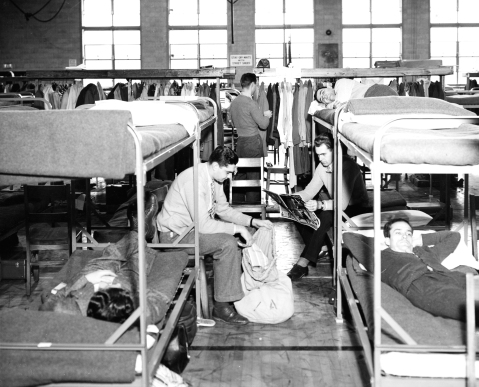
Quonset Hut Village, 1946; A000106
With the start of a new school year, students move into either the campus dorms or off-campus housing. It’s always exciting to move into a new place, but what if you were starting your new school year in a Quonset Hut or a trailer? That was the reality for thousands of MSU students and new faculty members in 1946 and throughout the 1950s.
After the end of World War II, soldiers returning home were looking to continue on with their lives, by either returning to work, getting married and starting a family, or attending school. Now that returning soldiers had access to funding from the G.I. Bill, MSU President John Hannah opened up the college and welcomed the returning soldiers to campus. However, there was one huge problem: where to put the influx of students?

WWII Veterans Bunk in Jenison Fieldhouse, 1946; A000351
In 1946, the population of campus doubled in size. Campus went from 7,500 to 15,000 students, with 250 faculty members also being added. With the explosion of people, there wasn’t enough permanent housing for everybody. To prepare for the influx, plans were made to house the faculty along with married students. The temporary housing structures for the students included: 449 demountable trailers for families, grouped around 16 attractive service buildings constructed by the College; 104 Quonset Huts to house 1,456 single men, together with a bath house with forty showers and a cafeteria and kitchen to feed 2,000 persons; steel barracks to house 240 single men; and 1,100 family units erected by the Federal Public Housing Authority. For faculty members, 50 temporary houses were built, which included 32 Quonset Huts and 18 British Empire Flat Top houses (Brookover Memoir). With all the new construction taking place, not everything could be completed by the summer of 1946. For that reason, 600 men slept in bunk beds on the floor of Jenison Fieldhouse, and 200 women slept on the top floor of the Union until other housing became available.

Aerial View of Campus over the Temporary Housing Area, 1946; A000074
The temporary housing spread across a large portion of campus. The Quonset Huts and the cafeteria were located in the area of campus where the Breslin Center is now. The trailer housing was located between Harrison and Kalamazoo Streets. The faculty brick apartments were located on Cherry Lane, which was between Harrison and Birch Streets, and the temporary apartments were located between Birch and Chestnut Street. (This description of locations is based off a map of campus from 1950.)
Surprisingly, people have fond memories of living in the Quonset Huts. The men returning from war didn’t mind living in the Quonset Huts because it was something they were already used to from living in the army barracks during the war. According to Edna Brookover’s memoirs about living in the Faculty Quonset Village, she did admit that she cried after visiting campus and learning she would be living in a Quonset Hut, but after moving in and settling into her new life, she enjoyed it. She talked about how the Village was a true “cosmopolitan community” with all the various people and children interacting with each other. As stated by Brookover, “there was always a friend around and a pot of coffee ready at most neighbors’ homes. One could always borrow an egg, a cup of sugar, or whatever. We learned to share. We formed car pools, baby sitting leagues, etc.”
The University and the Director of Married Housing on campus were very responsive to the needs of the Quonset Hut Village community. A storage Quonset Hut, playground equipment, a nursery school, a postal station, and a cooperative grocery were built to help support the Village. As time passed, people saved enough money to buy a house off campus, and as new dormitories were built, students moved out of the barracks.

Quonset Cafeteria, circa 1946; A000378
The Quonset Huts were only supposed to be occupied for a few years, but instead, some stood until the late 1980s! Faculty still lived in the huts as late as 1959, and WKAR broadcasted most of their programs from the large cafeteria Quonset Hut that was converted into a television station. As the years passed, the Quonset Huts were used for different purposes but were slowly demolished. In 1981, six of the last standing twenty Quonset Huts were torn down, and the rest were razed either in 1987 or 1988 to make room for the Breslin Center.
The Quonset Huts and other interim housing structures were a temporary fix to help the overcrowding of students coming in after the end of WWII. This explosion of people would help lead MSU to become the university that it is today. To learn more about what life was like living in a Quonset Hut, visit the Archives and read Edna Brookover’s “Life in Faculty Quonset Village on Cherry Lane-1946” which is part of collection UA 17.156 Wilbur Brookover Papers.
Written by Jennie Russell, Assistant Records Archivist





Leave a comment